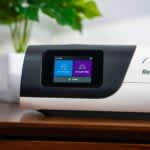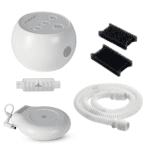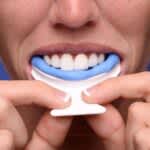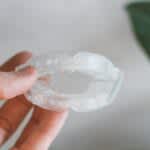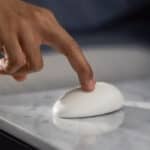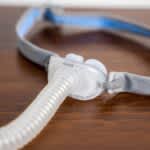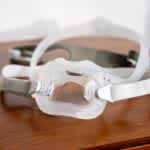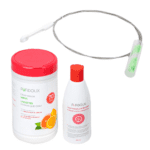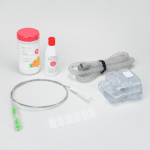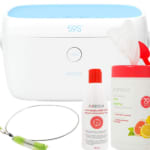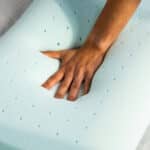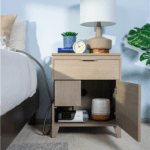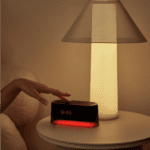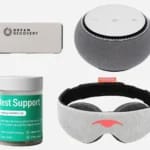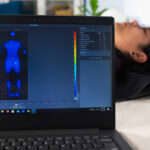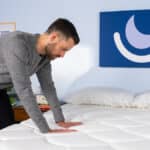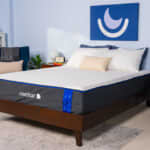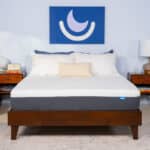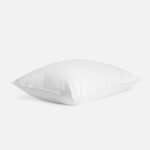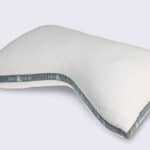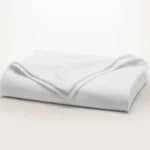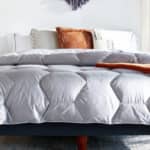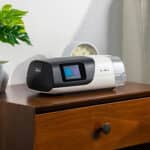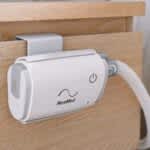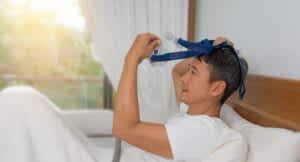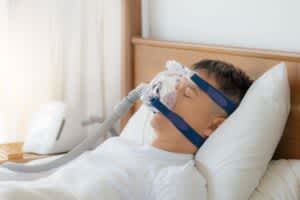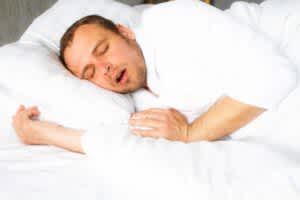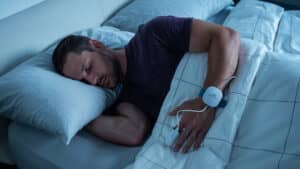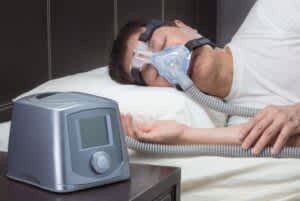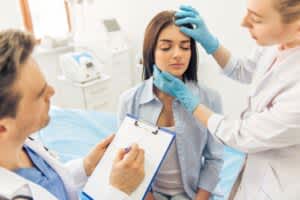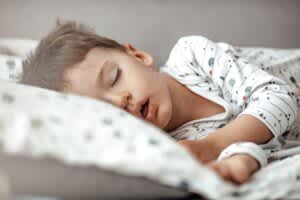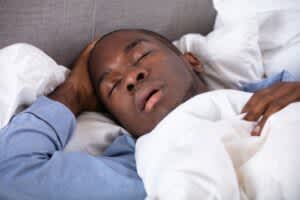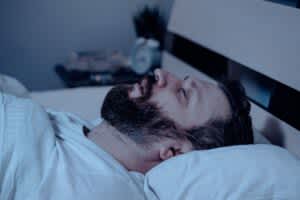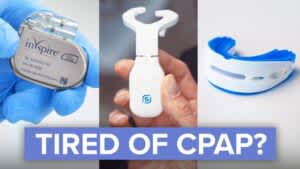Medical Disclaimer: The following content should not be used as medical advice or as a recommendation for any specific treatment. It is important to consult your health care provider prior to starting a new treatment or altering your current treatment plan.
Sleep apnea treatments can help reduce the symptoms of sleep apnea and improve sleep quality. Many treatments are available and doctors tailor the approach for each person based on several factors, including the type of sleep apnea, the severity of symptoms, and the condition’s underlying cause.
There are two types of sleep apnea, both of which cause reductions or pauses in breathing during sleep. Obstructive sleep apnea (OSA) is a common sleep disorder that occurs when the upper airway momentarily collapses during sleep. Central sleep apnea (CSA) is less common and is caused by problems with messages sent by the brain that control breathing.
Without treatment, sleep apnea can degrade your sleep quality, cause daytime symptoms like excessive sleepiness and impaired thinking, and pose certain health risks. We take a look at the various approaches to treating sleep apnea as well as the importance of talking to your doctor about finding the right treatment for you.
Lifestyle Changes
Many people with OSA have one or more risk factors that increase their chances of developing breathing issues during sleep. Along with consulting a doctor and taking a home sleep test, lifestyle changes can be helpful for people hoping to alleviate breathing disruptions and improve their overall health. In most cases, these approaches are recommended in addition to medical treatment.
- Weight loss: Obesity can cause or worsen the symptoms of OSA. Although losing excess weight is unlikely to eliminate sleep apnea altogether, it can help diminish symptoms.
- Get enough sleep: People with sleep apnea should aim toward getting at least seven to eight hours of sleep per night.
- Avoiding certain substances: Alcohol, along with medications like opioid pain medicines and benzodiazepines, may aggravate both central and obstructive sleep apnea symptoms. People should speak with their doctor about whether changes in medication could improve nighttime breathing issues.
- Change sleep position: In some people with OSA, airway collapse is worse when they sleep lying on their back, so sleeping on their side is preferable. There are positioning devices that can help people remain in an optimal position during sleep.
Snoring? An At-Home Sleep Test May Be the Answer

Save 54% on your Sleep Test Today
Simple and convenient
- Equipment delivered to your doorstep
- One overnight test in the comfort of your own bed
Uncover sleep apnea
- Quietly collects data while you sleep
- 98% effective in detecting sleep apnea
Affordable & ships fast
- In-lab sleep tests cost ~$3,000+ (this one’s $189), HSA/FSA eligible
- Arrives in 2-4 business days
Positive Airway Pressure (PAP) Devices
Positive airway pressure therapy uses a machine to pump pressurized air into the upper airway during sleep. There are several types of PAP devices, which are a common and highly effective way of preventing the airway from collapsing during sleep and reducing symptoms of OSA. PAP therapy is also used to treat certain types of CSA.
It is sometimes hard for people to use their PAP machine regularly because it can be uncomfortable. Working closely with a doctor can help resolve any discomfort or other issues that make it challenging to use the PAP machine as prescribed.
Continuous Positive Airway Pressure (CPAP)
CPAP machines provide a continuous stream of pressurized air during sleep to keep the airway open. The fixed rate of airflow that an individual needs from their CPAP machine can be determined during a sleep study. By preventing airway collapse during sleep, CPAP therapy can reduce breathing disruptions and alleviate daytime symptoms linked to sleep apnea.
Auto-Adjusting Positive Airway Pressure (APAP)
APAP machines, also called auto-CPAP machines, automatically adjust the level of pressure used to prevent airway collapse. Rather than operating at a fixed rate of airflow determined during a sleep study, APAP machines use sensors to detect breathing changes and increase or decrease the air pressure as needed.
Bilevel Positive Airway Pressure (BiPAP or BPAP)
BiPAP machines deliver different rates of air pressure that are higher when a person is inhaling and lower when they are exhaling. BiPAP machines are programmed by a doctor based on the results of a sleep study. A BiPAP machine may be recommended in people with OSA who have difficulty using CPAP or in people with certain types of CSA.
Adaptive Servo-Ventilation (ASV)
ASV machines can sense changes in breathing and adjust airflow based on a proprietary algorithm, while also using rates that are programmed after a sleep study. ASV may be recommended for people with CSA that is caused by sedatives or certain health conditions, as well as in those who cannot use more common types of positive airway pressure therapy.
Expiratory Positive Airway Pressure (EPAP)
EPAP therapy does not require a bedside machine. Instead, EPAP therapy keeps the airway open during sleep using a nasal device. The device has valves that create resistance upon exhalation, using a person’s own breath to keep their airway open. Although more research is needed, EPAP therapy may be recommended for people with mild OSA who have already tried CPAP therapy.
Medication
In December 2024, the Food and Drug Administration approved weight loss drug Zepbound to treat moderate to severe obstructive sleep apnea in patients with obesity. The medication is the first to be specifically approved for the treatment of OSA. The approval came after two clinical studies, funded by the drug’s manufacturer, Eli Lily, found that patients given tirzepatide (the active ingredient in Zepbound and Mounjaro) experienced 20-23.8 fewer respiratory events (breathing disruptions) per hour after 52 weeks versus patients given a placebo. While PAP therapy remains the gold standard of OSA treatment, the drug’s approval gives patients another option.
Oral Appliances
Oral appliances help adjust the position of the jaw or tongue to keep the airway open during sleep. The use of oral appliances to treat OSA may be most appropriate for people whose sleep apnea is not severe or who cannot tolerate positive airway pressure therapy. Several types of oral appliances are available.
Mandibular Advancement Devices
Mandibular advancement devices, also called splints, are the most common type of oral appliance for OSA. These devices are held in place by the teeth and cause the jaw to move forward, which opens the airway and reduces nighttime obstructions.
Tongue-Retaining Devices
Tongue-retaining devices reposition the tongue using suction. Holding the tongue in place at the front of the mouth prevents it from falling back and blocking the airway during sleep. Although this method of treating sleep apnea has not been widely researched, these devices may be a good choice for people who have dental problems or have not responded to other treatments.
Rapid Maxillary Expansion
Rapid maxillary expansion widens the upper jaw and nasal passages to create more space in the airway. The treatment involves a metal device that is attached to several teeth which uses screws to slowly exert the pressure needed to widen the upper jaw. This device can help to reduce OSA in certain children, including those who still have sleep apnea after surgery.
Surgery
Sleep apnea surgery involves removing or repositioning bone and tissues in the upper airway. While surgery is not a first-line treatment for most adults with OSA, it is an option for some adults who cannot tolerate or have not improved with other treatments. Surgery can be used alone or in combination with other treatments.
Surgery is commonly used as a first-line treatment in children. Children with sleep apnea often have enlarged tissues in the throat that, when removed, can reduce the risk of breathing disruptions during sleep.
A number of surgical procedures can increase the space within the airway or stabilize it and prevent collapsing during sleep.
Mouth And Throat Surgery
Mouth and throat surgeries are the most common surgeries used to treat OSA in adults. These surgeries remove, reshape, and reposition tissues in the mouth and throat that interfere with breathing. These tissues may include the flap of soft tissue that hangs from the back of the mouth called the uvula and the tonsils or adenoids.
Jaw Surgery
Some people with OSA benefit from surgery that repositions the jaw. By moving the bones and soft tissues of the jaw forward, the space within the throat is increased. Jaw surgery is usually only performed on patients whose jaw shape causes issues with breathing, or whose OSA has not improved despite other treatments.
Tongue Surgery
Sometimes the size or position of a person’s tongue can contribute to OSA. Surgery may be performed to reduce the size of the tongue, stabilize it, or reposition it and prevent it from obstructing the upper airway. Tongue surgery is often performed along with other surgeries for sleep apnea.
Nasal Surgery
Nasal surgeries address breathing issues originating in the nose. Rather than treating sleep apnea, surgery to the nose or nasal sinuses is used to make positive airway pressure like CPAP and other sleep apnea treatments more effective.
Nerve Stimulation Treatment
Nerve stimulation treatments are newer approaches to treating sleep apnea. Their use is increasing among people who want to treat sleep apnea without CPAP or for whom CPAP is ineffective.
- Hypoglossal nerve stimulation: This treatment for OSA uses a device that is implanted into the chest to stimulate a nerve that affects muscles in the tongue. This stimulation helps to move the tongue forward, which opens up the airway. The device is activated using a remote control so it can be turned on before a person sleeps.
- Phrenic nerve stimulation: Phrenic nerve stimulation is used to treat CSA. This therapy also involves the implantation of a nerve-stimulating device in the upper part of the chest. Phrenic nerve stimulation is programmed to stimulate nerves that control the diaphragm, which is a muscle that contracts rhythmically during breathing, and restarts breathing if it stops during sleep.
Talk With Your Doctor About the Right Treatment For You
Finding the right treatment for sleep apnea can improve your sleep, alleviate daytime symptoms, and reduce your risk of long-term health complications. Your doctor can help find the best treatment for your sleep apnea by conducting a comprehensive evaluation and scheduling regular follow-ups to address any challenges that arise during treatment.
Positive airway pressure therapies such as CPAP are the standard treatment for most people with sleep apnea. Using a CPAP device nightly can be challenging to get used to. Tell your doctor if you are having problems sticking with CPAP treatment because there are many ways it can be made more comfortable for you.
References
Ask the Sleep Doctor
Have questions about sleep? Submit them here! We use your questions to help us decide topics for articles, videos, and newsletters. We try to answer as many questions as possible. You can also send us an email. Please note, we cannot provide specific medical advice, and always recommend you contact your doctor for any medical matters.

